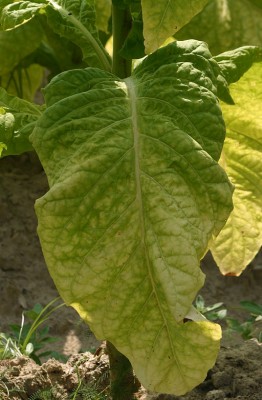If you found out you couldn’t run to your local supermarket or corner quick stop for many of the things you use every day, what would you do? Many people are answering this question by learning to live without commercially made products. This doesn’t mean these people are suffering or having to live without little luxuries.
Tobacco has been a cash crop for many, many years. Growing and curing chewing tobacco is a process that you can learn to do at home, whether or not you actually use the product. In fact, being able to supply items like alcohol or tobacco can be a real boon in a survival situation, as many people will be willing to pay or barter quite a bit for them, which can keep you living comfortably in an otherwise difficult situation.
Tobacco Growing
First, you need to find a good tobacco source. You can buy tobacco seeds from other tobacco growers. (You can store seeds for two to three years if you buy too many.) Choose your seeds based on what you are going to do with the tobacco. Different types are used for smoking and chewing. Tobacco will grow in all fifty states so you shouldn’t have to worry about where you live. However, certain varieties may be more suited to one environment over another. Choose a variety that is adapted to your region in order to maximize your crops.
When germinating seeds, you should count on one tobacco plant to produce about five ounces of dried tobacco. Plant your tobacco about four feet apart to give you room to walk between the plants. When you see flowers forming at the top, you should remove the terminal bud. This is called topping the plant, and it allows the leaves to get much thicker and larger than they would be if left untopped. Remove the top before the flower opens and watch for the suckers to appear on each leaf. These suckers must be removed manually to increase the tobacco yield.
Harvesting and Curing
The first tobacco harvest can begin when the lower leaves start showing a yellowish color. This is typically three to four weeks after topping the plants. You can then remove leaves at one-to-two week intervals. You can also harvest the tobacco by cutting the entire stalk down and hanging it upside down to cure. Either way works, so you can choose the method that fits your lifestyle.
Once you have your tobacco harvested, you need to cure it. You can string your tobacco leaves on a cord or wire that you run through each leaf. You need to space the leaves an inch apart to give them room to breathe while they dry. You should hang your tobacco in a room that is warm, dry and has good airflow. You need to leave your tobacco leaves hanging until they are a light to medium brown color. If you prefer a mellow tobacco, let them hang even longer.
New Survival Seed Bank™ Lets You Plant A Full Acre Crisis Garden!
Many people avoid tobacco production due to the time involved in curing. It can take one to three years to cure a tobacco harvest properly. Home tobacco growers have to rely on air to cure their tobacco. Commercial curing is quicker due to using heat. It is not practical for the home grower to use heat; however, there are some home growers who have build home curing facilities and may offer them for sale.
Next, you need to prepare the tobacco for aging. You can shred or chop it by hand or using a food processor. This breaks the tobacco down to a usable size. If you are making chewing tobacco, you can base your chopping on the size you normally find in a pouch of tobacco.
You are now ready to make your flavoring agent that will keep your tobacco moist and prepare it for aging, if you are going to age it. Reduce two cups of apple juice until it is thick, approximately half the original volume. Add one or two tablespoons of molasses for taste. Next stir in your chopped tobacco and mix well to coat. You can now seal your tobacco up for use or store it for aging.
Aging
Commercial tobacco is aged before it is packaged and sold for use. Aging can take anywhere from one year to five or six years. Home tobacco growers may find this the most difficult part, as it takes patience and the proper moisture conditions to age without mildew and rot ruining the tobacco. Aging is a trial-and-error procedure for the home grower, much like using flavoring agents. Many home tobacco growers store their tobacco in oak casks while it ages. The length of time you allow your tobacco to age will depend on your personal taste. When you are satisfied with the product, you can seal it in baggies for use.
Advice for Home Growers
Growing tobacco may not be the huge success you want it to be on your first harvest. However, give yourself time, and you will master the art of growing, harvesting, and curing tobacco at home. These tips will help you get started.
- Sun curing your tobacco leaves will cause them to turn yellow and have a very sweet flavor.
- Many home growers soak their dried tobacco leaves in green tea. The green tea draws some of the nicotine out of the leaves.
- If you don’t have room to plant rows of tobacco plants, you can grow them in three-gallon containers with one plant per container.
- Make sure you check your local laws before growing any tobacco product.
Here’s The Best Part For Non-Smokers:
If we find ourselves in a real economic meltdown, there’s going to be a lot of smokers out there going through tobacco withdraws. Tobacco will be a great barter item. If you and your family are in need of weapons, food, and fuel, tobacco will be a very high value barter item.
Disclaimer: As always, growing tobacco should be done according to all local and state laws.
 Off The Grid News Better Ideas For Off The Grid Living
Off The Grid News Better Ideas For Off The Grid Living





